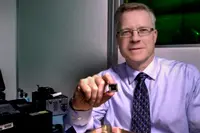 A team of engineers at NASA has been chosen to build the space agency's first ever integrated photonics communications modem. This could transform everything from telecommunications, medical imaging, and advanced manufacturing to national defence.
A team of engineers at NASA has been chosen to build the space agency's first ever integrated photonics communications modem. This could transform everything from telecommunications, medical imaging, and advanced manufacturing to national defence.
The modem will be tested aboard the International Space Station beginning in 2020 as part of NASA's multi-year Laser Communications Relay Demonstration (LCRD). The mobile phone-sized device incorporates optics-based functions, such as lasers, switches, and wires, onto a microchip.
Once aboard the space station, the so-called Integrated LCRD LEO (Low-Earth Orbit) User Modem and Amplifier (ILLUMA) will serve as a low-Earth orbit terminal for NASA's LCRD.
Don Cornwell, director of NASA's Advanced Communication and Navigation Division, said: “NASA has relied exclusively on radio frequency based communications since its inception in 1958. Today, with missions demanding higher data rates than ever before, the need for LCRD has become more critical.”
LCRD promises to transform the way NASA sends and receives data, video and other information. It will use lasers to encode and transmit data at rates 10 to 100 times faster than current communications equipment, requiring less mass and power.
Recent developments in nanostructures, meta-materials, and silicon technologies have expanded the range of applications for these highly integrated optical chips. Furthermore, they could be lithographically printed en masse, driving down costs.
Mike Krainak, who is leading the modem's development at NASA's Goddard Space Flight Centre, said: "The technology will simplify optical system design. It will reduce the size and power consumption of optical devices, and improve reliability."
Although the modem is expected to use some optic fibre, ILLUMA is the first step in building and demonstrating an integrated photonics circuit that ultimately will embed these functions onto a chip.
"What we want to do is provide a faster exchange of data to the scientific community," Krainak said. “The goal is to develop and demonstrate the technology and then make it available to industry and other government agencies, creating an economy of scale that will further drive down costs.”
Although integrated photonics promises to revolutionise space-based science and inter-planetary communications, its impact on terrestrial uses also is equally profound. One such use is with data centres. Integrated photonics promises to reduce the cost and size of data centres while promising faster computing power.
Pic: NASA laser expert Mike Krainak and his team plan to replace bulky fibre-optic receivers with an integrated-photonic circuit, whose size will be similar to the chip he is holding.
Author
Tom Austin-Morgan
Source: www.newelectronics.co.uk

